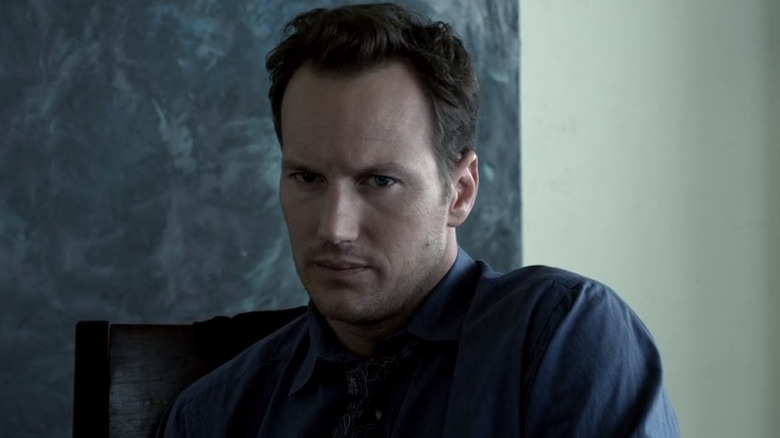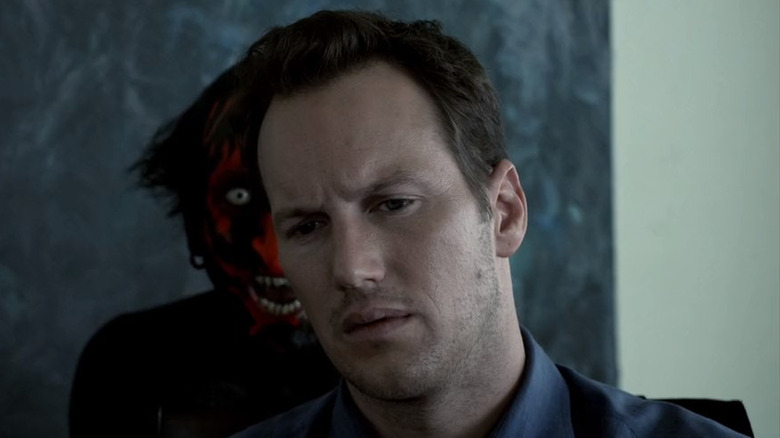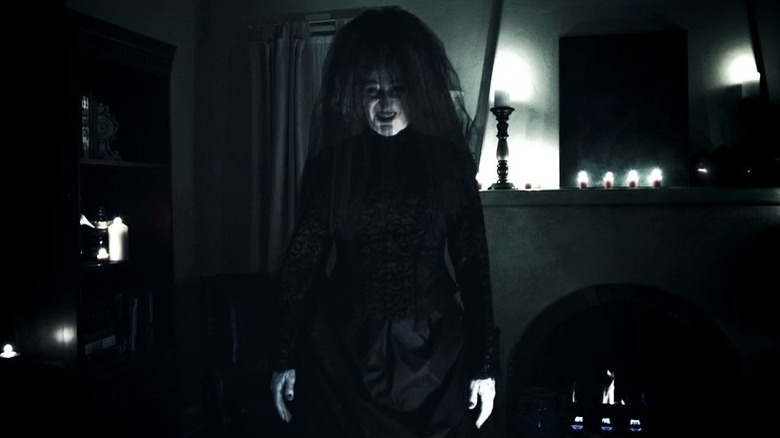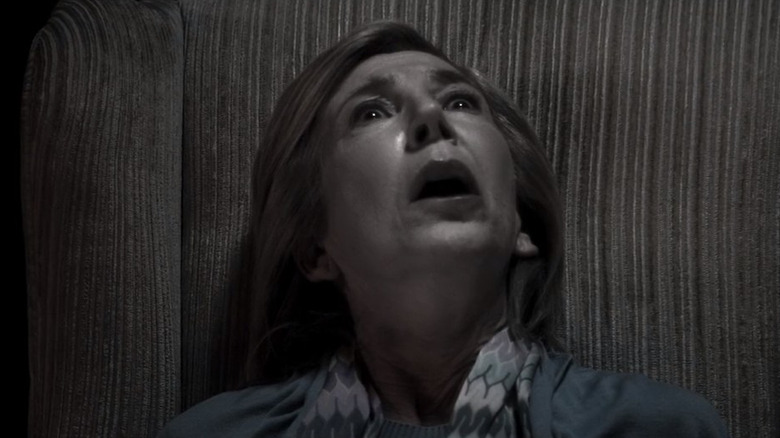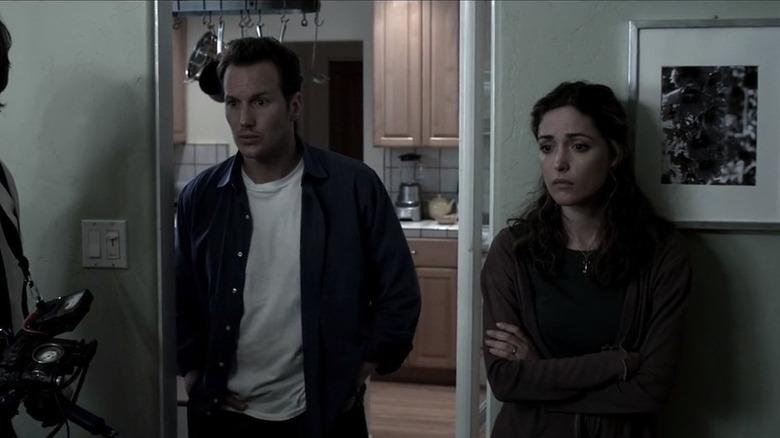What Makes Insidious So Scary?
What makes a scary movie scary? For a while, it was the shock and awe of the genre. When "The Exorcist" came out in the 1970s, people hadn't seen anything like it, and it therefore revolutionized the horror genre. When slasher films of the '70s and '80s became a staple, it was because the thought of some real-life adversary with a chainsaw, axe, or knife was so plausible it was bone-chilling. Of course, by the time "Insidious" was released in 2010, all of the genre's tropes were tired and overdone, meaning James Wan had to refresh them all, which he did phenomenally by doing them all slightly differently than his predecessors.
So what makes "Insidious" one of the scariest movies of all time? Well, science, for one, and using all of the same tropes used before while abandoning them simultaneously. The story follows a family moving into a haunted house (not original), but they leave it halfway through. They find out their son is in the process of being possessed (not original), but this time by a demon in a place called the Further. Of course, they can only turn to a team of paranormal experts (again, not original), only this time, the main expert is the surprising protagonist of the whole franchise.
Wan is the architect of the "Saw" and "The Conjuring" franchises, so it shouldn't be a surprise that he was able to launch "Insidious" into another franchise scary enough to revolutionize the movie industry. But how did he use jump scares, sound effects, and a terrifying villain in a different way? He used creative alternatives.
Science proves it has the most terrifying jump scare
Jump scares are a staple in horror movies. At any given moment, while someone is searching the house for the intruder, a cat will jump out of the shadows and startle the protagonist and the audience as well. Of course, once that became a popular trope, it seemed every horror movie wanted to scare the jeepers out of their audience by using cheap jump scares. But James Wan did it a little differently, which is proven by science to be the scariest one.
In 2020, a U.K.-based study called Science of Scare set out to see what the scariest movie of all time is. And while the research found numerous winners, the most terrifying jump scare hasn't changed since day one, as it went to one of the best scenes in "Insidious," when Josh Lambert (Patrick Wilson) listens to his mother (Barbara Hershey) tell him about a dream she had the night before, one that sees her meet the red-faced demon. When the story finishes, she comes face-to-face with the demon from the dream, crouching behind her son.
Typically, when a cat jumps out to give the audience a cheap scare, it precedes the scariest part of the scene, when the killer jumps out as soon as the protagonist relaxes. Wan flips it on its head. The scariest part of the scene finishes after the dream, only to have the audience start to relax and think it is over before the face of the demon stops your heart. We think it is the most frightening jump scare in any movie, and thanks to science, we're not alone.
The score built the tension
As you may know, we have five senses (except for characters in many of these movies that see dead people with the sixth). One of the most important senses for a scary film is hearing, and many of these movies use sound to build tension and emotion, telling us when and what we should feel. Sound designer Robert Cross ("Saw") and composer Joseph Bishara ("The Conjuring" franchise) expertly combined their powers to make this one of the more unsettling films audibly.
One scene in particular that sets this film apart from others is the baby monitor scene. Sure, M. Night Shyamalan may have used a baby monitor to connect his characters with the otherworldy threat in "Signs," but Cross built tension by having Renai Lambert (Rose Byrne) play a low and slow-paced song on the piano before cutting the sound off completely, only to be left with the whispers of something in her son's room. We follow Renai to the bottom of the stairs; no music, complete silence beside the terrifying whispers, only to be hit with a blood-curdling scream on the monitor and the music to kick in, stopping our hearts.
Another example is the first time Elise Rainier (Lin Shaye) meets the demon. When she walks into the boy's bedroom, the camera changes to put us behind the ceiling fan while the spinning rotor sounds suspiciously like a heartbeat. One that is sped up as she describes the horrifying appearance of the demon's blood-red face.
Insidious features a compelling villain
Villains in horror movies can be filed under a few different categories. These include slashers like Ghostface, Jason Voorhees, and Michael Myers, aliens in films like "Alien," "Invasion of the Body Snatchers," and "Signs," and supernatural forces like the ones in "The Conjuring," "Paranormal Activity," "The Exorcist," and so on. While there are dozens of horror subgenres, these are the norms that have become a little more tired.
"Insidious" uses the supernatural-type villain by setting the story of a red-faced demon bent on possessing Josh's son Dalton (Ty Simpkins) throughout the film. But James Wan refreshes the idea in his own way. There is always the question of why didn't the families ever leave these haunted houses in movies in the past, but the Lamberts leave halfway through, only to find out that the entity is haunting them, not the house. This leaves us with a feeling that they have nowhere to run. The second way he updates the tropes is by making this a legacy problem. It isn't bad luck that the Lamberts move into the wrong house at the wrong time. Instead, they are sought out because the father and son can both travel to The Further.
Josh has a similar supernatural stalker in his childhood in The Bride in Black, a former serial killer who returns to Josh in the astral plane and eventually takes his body at the end of the first film in hopes of living a normal life. Not only do we get a terrifying villain in the first film, but the secondary villain thrusts us into an unavoidable sequel, making us feel like this is a neverending battle.
The subject matter is plausible
We've all seen the scary movie where our hero finally bests the adversary, killing them once and for all, only for Michael Myers, Jason Voorhees, or the Fisherman with the hook to come back inexplicably unkillable. While this is great for the ability to do a second, third, or 15th film, it takes us out of the terrifying aspect of realism.
However, we have all felt that uneasy feeling that we aren't alone. Most of us have seen something we can't explain or aren't sure was real. Our overactive imaginations (maybe caused by watching too many "Insidious" movies) cause us to create these moments in our minds. James Wan translates that with the perspective of an outsider. The camera follows our characters, sometimes shakily, to give us the feeling that we are watching them from the outside. Sure, the idea of a place existing somewhere between our world and the next is unbelievable to some; the feelings of unease, paranoia, and fear of the unknown are all too real.
Jump scares are no longer cheap, gore is no longer needed, and the unbelievable is no longer the safe space we got used to with horror movies. Instead, "Insidious" is so scary because the jump scares are perfectly timed to startle us, the fright comes from real-life unease and unsettling sound effects instead of over-the-top gore, and we no longer feel safe in any house because the danger comes from our own imagination.
